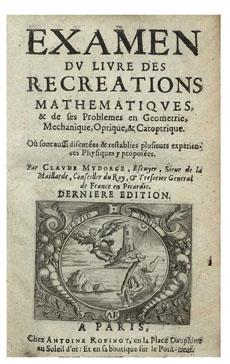Claude Mydorge (1585–1647) is a remarkable figure closely linked into the intellectual circle around Mersenne and Descartes. Educated by the Jesuits at La Flèche, the school also attended by Mersenne and Descartes, he received a degree in law, but never practiced law. Coming from a wealthy and influential family he was assigned an administrative post which left him ample time to devote to his interests, being mathematics, optics, and astronomical observations. Mydorge is reported to have spend close to 100.000 écus during the 1620's on the fabrication of lenses and burning mirrors (Baillet 1691, II, 326). During the years 1627–28 he commissioned the grinding of oval, elliptic, parabolic, and hyperbolic lenses for his own use and for experiments by Descartes (Baillet 1691, I, 150). In addition to this considerable financial investment, Mydorge devoted much of his time experimenting with these optical devices. However, his findings and insights are only sparsely recorded. The four extra books of his Prodromi catoptricorum et dioptricorum, reporting on his experiments with refraction were reportedly lost when William Cavendish brought them to England. Mydorge's son found three little treatises on optics in his estate (De la lumière, De l'ombre, De la sciotérique) which were subsequently lost. The extant sources that inform us about his optical experiments are limited to 1) his correspondence with Mersenne and Descartes, 2) some references by Mersenne in his Quaestiones celeberrimae in genesim of 1623, and 3) notes on optical experiments in the book Récréation mathématique (RM), first published in 1624. Only the first source has been used in studies concerning Mydorge, such as by Burnett (2005) and Schuster (2013). While the two others have only been mentioned marginally, they contain important clues on the kind of experiments he was involved in. This study focused in detail on these neglected sources in order to reconstruct a picture of how hands-on experience with optical artifacts can lead to knowledge not readily available from the mathematical approach in geometrical optics.
This project fit into a larger project (funded by Research Foundation Flanders, FWO Vlaanderen) aiming to determine the kind of knowledge that is embedded (often tacitly) in material artifacts and contrivances, known from practical mathematics, and in the practices dealing with these objects. The project investigated the strategies used for extracting this knowledge and its application in theories on physico-mathematics at the beginning of the seventeenth century. As with many of the propositions in the RM, the optical artifacts discussed (colored glass, cut glass, lenses, camera obscura, mirrors, etc.) were known from the magical tradition in the sixteenth century (Cardano, Della Porta, ..). However, with the new physico-mathematics, their original use for enticing wonder and astonishment is transformed into an epistemological tool for extracting knowledge about causes and effects.

